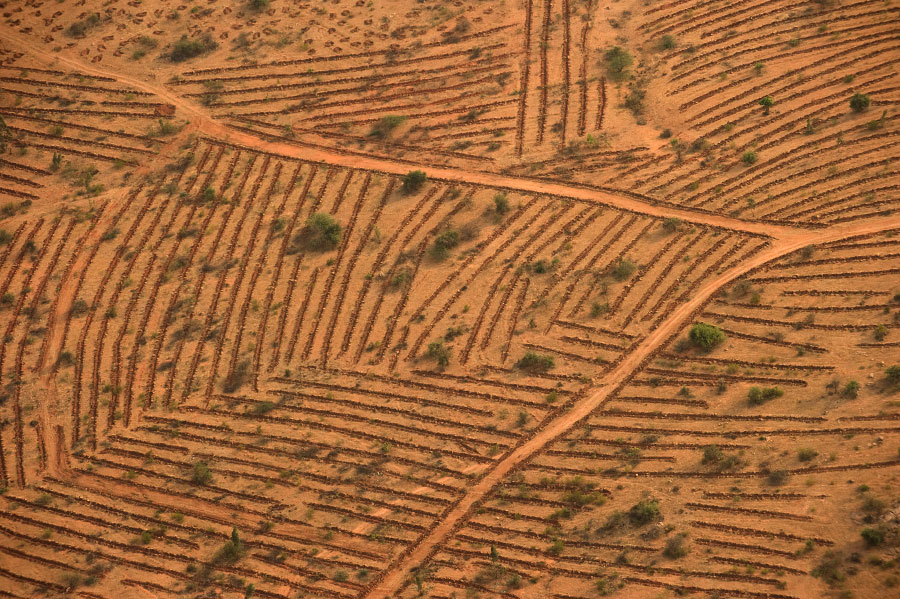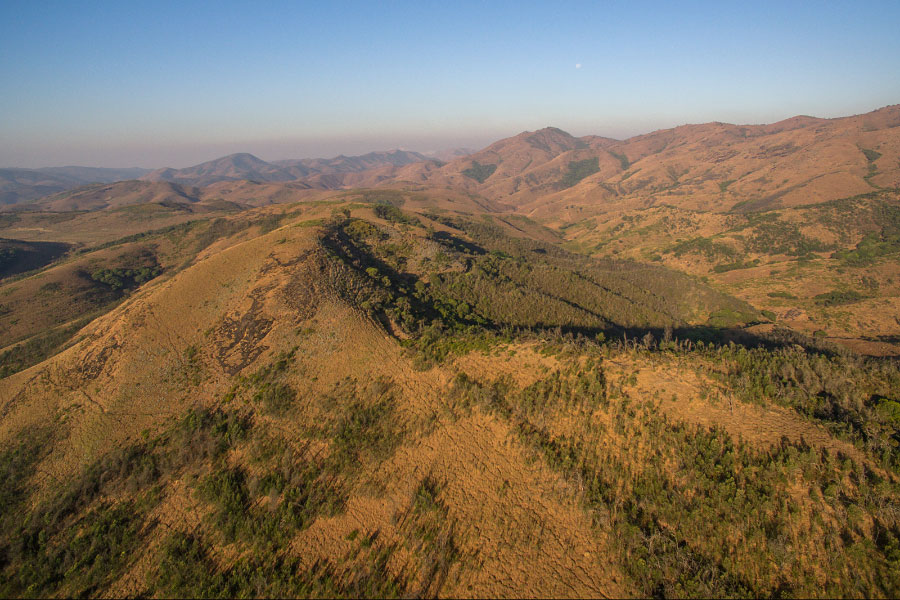It may not be an overstatement to say that grasses underpin much of human existence. From sustaining wildlife that fed early hunter-gatherers to eventually becoming food itself, grasses have contributed to the development and flourishing of human civilisations. From present day cereal crops, to even elegant furniture, grasses serve multiple uses in human societies, from the functional to the aesthetic. Yet, when it comes to judgement, the larger urban public and a range of government bodies tend to view grasses as a diminutive part of our ecosystems when compared to trees.
Driven initially by concerns over deforestation of large tracts of primary forests and more recently climate change, there is a strong, common interest in maintaining and boosting tree cover in India. However, a new wave of large-scale land-conversion, which fits with the ‘Green India Mission’, and appeals to the morality and conscience of politicians, forest departments and concerned citizens alike, is that of tree plantation and afforestation activities.
Some recent examples of large scale, target-driven tree plantation directives that have made headlines are: Maharashtra government’s decision (announced in Nov, 2016) to achieve planting of 50 crore tree saplings in next three years (2017-2019) in order to combat climate change and reach a 33% forest cover; Tamil Nadu government’s decision to plant 68 lakh tree saplings across the state to mark the former Chief Minister Jayalalithaa’s 68th birthday, now being followed by another plantation drive of 69 lakh trees at a whopping cost of 66 crores; Gujarat government’s plantation drive of 10 crore saplings during the 67th “Van Mahotsav” across the state in August 2016. While the numbers appear staggering to a non-expert, such initiatives are usually unscientific in implementation and show much laxity in aspects of monitoring.
But, what motivates the recent large-scale tree plantation drives? The general feeling is that tree plantations at large scales are necessary to compensate for current rates of forest loss, mitigate climate change, and support local people’s livelihoods. Given the unprecedented rates of urbanisation and agricultural expansion, tree plantations appear to be well-meaning efforts to ‘forest’ the remnant parcels of land. Such gargantuan tree plantation drives therefore emerge to be well-intentioned ‘need-of-the-hour’ solutions. Further, as a global commitment, India has pledged to restore 13 million hectares of degraded forests by 2020 as part of the Bonn Challenge (2015) to sequester carbon, conserve biodiversity, and provide livelihoods for the poor.
Much ado about large-scale tree plantations
In this article, we assert that while planting trees is important, decisions about the where, what and how of these plantations are critical and have been largely disregarded in this mission to achieve a ‘greener’ India. While the guidelines issued by the Environment Ministry for Green India Mission are exhaustive, the reality behind many rapid-action plantation drives appears otherwise. Arguably, the most unfortunate oversight appears to be in differentiating between planting trees on deforested land (reforestation/ restoration) and planting trees where they did not historically occur (afforestation), at least not at very high densities. This neglect is not only an India-specific problem, but mirrors global disregard for habitats where tree cover is naturally sparse.
A case in point is that of the Atlas of Forest Landscape Restoration Opportunities, an interactive online map that was published by the World Resources Institute (WRI) in 2014 and identified 23 million km2 of the world’s land as potential areas for forest restoration. A study (Veldman et al., 2015) later pointed out that 9 million km2 were misclassified as WRI wrongly considered grass-dominated ecosystems as ‘deforested’ or ‘degraded’ landscapes.
The Green India Mission, on its part, similarly aims to restore/afforest 5 million hectares of forest/non-forest lands, among which feature grasslands, scrub lands, ravines, and cold deserts. These landscapes are often called ‘wastelands’ and the term inherently implies that the land could be diverted to tree plantations in this case. Contrary to popular belief, such regions are often unique and fragile ecosystems which support a suite of highly adapted biodiversity (which include grasses and forbs) and offer a multitude of ecosystem services. Below we highlight some common grass-dominated natural habitats which are targeted for such massive afforestation initiatives and discuss problems and consequences as a result of afforestation, citing examples from India and different parts of the world.
- Arid and semi-arid grasslands and scrublands of central, peninsular, and western India are regions where tree canopy is open and the understory is dominated by grass. A recent study (Ratnam et al., 2016) classifies such habitats as ‘savannas’ – something that most people may have heard of, used to describe the vast plains of Africa teeming with charismatic wildlife. However, such savannas are found even in India! In fact, a large part of India was woody savanna shaped by dynamic processes such as rainfall, fire, and herbivore grazing, before large-scale human modification took over.
These systems are often ‘forested’ with species such as neem (locally non-native), Eucalyptus, Casuarina, Gliricidia (all exotic) and Prosopis (exotic, invasive). Sometimes locally-native species of Acacia, Zizyphus and many others are used, but planted at abundances beyond what the natural environment of such an ecosystem can support (see image).
- Montane grasslands associated with Shola forests in Western Ghats of southern India, are high elevation grasslands sustained mainly due to their ability to tolerate harsh frost and possibly fire events (Thomas and Palmer, 2007). These grasslands have existed even prior to human habitation and maintained by monsoonal patterns over large time scales (Rajgopalan et al., 1997).
These landscapes were planted with exotic species like Eucalytpus (Eucalyptus globulus), Pine (Pinus patula) and Wattle (Acacia mearnsii, invasive) for fuelwood and timber (See image). In the Nilgiris and Palani hills of Tamil Nadu, these plantations have existed for the last 150 years and by 1988, over 11,000 hectares of grasslands had been converted to plantations (Ahrestani, 2016). Efforts are underway to ‘restore’ these landscapes with native Shola tree species in those areas where they have possibly existed in the past (e.g. the Nilgiris in Tamil Nadu; Arasu, 2016), however haphazard plantations to meet arbitrary targets can have adverse ecological consequences.
- Lateritic and basaltic rock outcrops existing along coasts and hill ranges of Western Ghats, dominated by grasses and herbaceous vegetation, are part of the Deccan traps continental flood plain and their origin dates back to roughly 60 to 32 million years ago (Widdowson and Cox, 1996). These landscapes are usually devoid of large trees and may appear barren in the summer months, but show a tremendous diversity of plants during the monsoon. Specialized plant communities have evolved in the harsh physical environments, such as thin soil layer and poor nutrient conditions of these plateaus. Some rare animal species (e.g. Xanthophryne tigerina) have evolved to survive in such open rocky environments.
These landscapes have been ‘forested’ with Northern black wattle (Acacia auriculiformis) and bamboo species (Watve, 2013).
The fact that many grass-dominated habitats have evolved over millions of years is very often disregarded during afforestation. This leads to tremendous losses to the natural landscape and its resident biodiversity, as well as large wastage of public money as many tree plantations fail over time. Some problems and consequences of large-scale tree plantations are:
Post-plantation mortality – In northern China, greater than 70% of the locally non-native trees planted in the arid and semi-arid landscapes as part of large-scale afforestation projects (1952-2005), died. These trees were not native to arid regions and were unable to survive periodic droughts, something that native grasses and tree species at certain densities are more equipped to cope with (Cao, 2008). Similarly, official evaluation of ten-year old plantations (2004-2014) in eleven forest circles of Maharashtra indicated 74% failure, 13% partial success and only 13% complete success (Bhargav and Dattatri, 2015).
Hydrological consequences – In comparison to grasses and other herbaceous vegetation, tree plantations have much greater water and soil nutrient demands (Jackson et al., 2005). Monoculture plantations in grassy landscapes can decrease ground water recharge and increase ground water depth drastically (ibid.). In shola-grassland landscapes in south India, changes in stream flows have been recorded due to decreased outflow from plantation areas with exotic tree species (Samra et al. 1999).
Consequences for biodiversity – Plantation sites in the shola-grassland ecosystem harbour low bird diversity (Khan, 1978) and a grassland-specialist bird, the Nilgiri pipit (Anthus nilghiriensis), showed 60% lower occurrence in wattle plantations (Vijayan and Gokula, 2006). Similarly, afforestation in savanna sites can reduce species richness and diversity of plants (Bond and Parr, 2010; Ratnam et al., 2011). This is mainly due to the loss of otherwise thriving, shade-intolerant forbs and grasses, to canopy closure (ibid.). Tree plantations could eventually affect grass (fodder) availability for wild and domestic animals and lead to loss of nesting-sites and habitat for grassland fauna – e.g. local extinction of blackbuck, a grassland antelope, from grasslands of Valmiki Tiger Reserve due to conversion to monoculture plantations in the 1960-70s (Sinha et al, 2015).
The Way Ahead
This article briefly highlights why large-scale tree plantation activities in some natural habitats are problematic. Such plantation targets set by governments, implementation agencies and supported very often by the general public in India suffer from two main lacunae: a) lack of appreciation and disregard for the role of natural habitats, especially grass-dominated landscapes, and b) no critical evaluation of the goals (e.g. poverty alleviation, watershed protection, biodiversity conservation) and the means of achieving them through such large-scale tree plantations (Fleischman 2014). Tree plantations can certainly add value in areas where much human-induced land-use change has already taken place. For example, urban centres, schools, road sides or hospitals could possibly have more trees.
Tree plantations are also more likely to contribute towards enhancing biodiversity when established on degraded lands (restoration) rather than replacing natural ecosystems such as grasslands, shrublands and open forests (Bremer and Farley, 2010). The outcome is likely to be positive for biodiversity when locally-native tree species are used. For example, the Nature Conservation Foundation is restoring fragments of rainforest using locally-native tree species in collaboration with Tea estates and Tamil Nadu Forest Department. The Vattakanal Conservation Trust has cultivated almost 300 plant species native to shola habitats for restoration in the Palni Hills of Tamil Nadu.
Occasions where tree plantations are necessary, maintaining a good stock of saplings/seeds of locally-native tree species in forest department nurseries can overcome the need to turn to non-native and exotic varieties of trees. Locally-native species can be identified by using a combination of regional flora, traditional knowledge, and consultation with experts in the field of botany and ecology to assess habitat suitability.
In native habitats where wild animals and birds could disperse seeds at no cost, thousands of rupees of public money need not be spent without undertaking any critical evaluation of the need or efficacy of such plantations. There is no prosthesis to actual protection of remnant forests and grassland habitats in order to conserve wildlife and people’s environment. It is high time that we use science to resolve current lacunae in policy and appreciate the role of grasses in savannas and tropical forests.
Read related article: To Chop, or Not to Chop? The Issue of Exotic Invasive Trees in the Western Ghats



 CI is a non-profit, non-commercial portal that aims to facilitate wildlife and nature conservation by providing reliable information and the tools needed to campaign effectively.
CI is a non-profit, non-commercial portal that aims to facilitate wildlife and nature conservation by providing reliable information and the tools needed to campaign effectively.